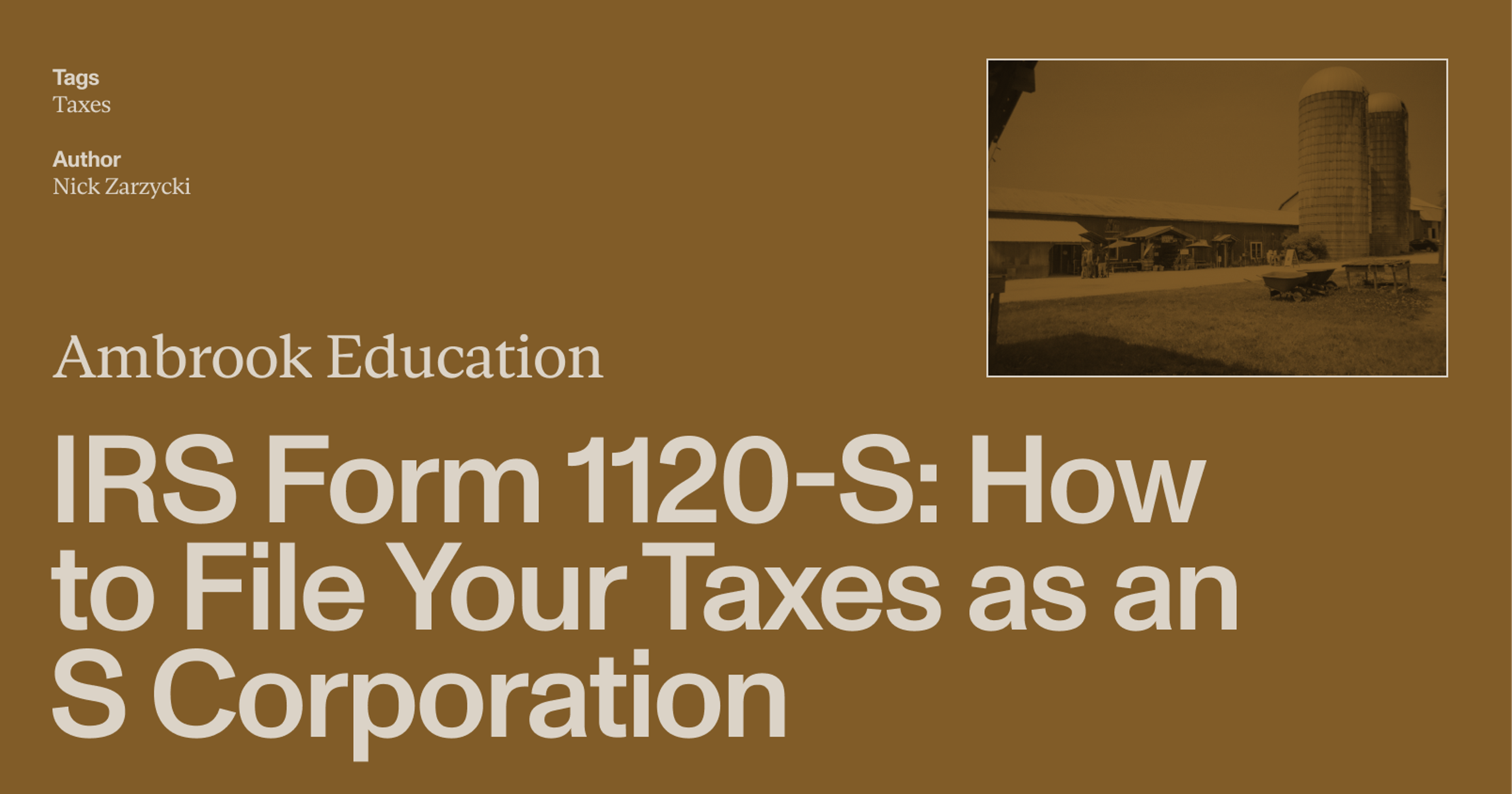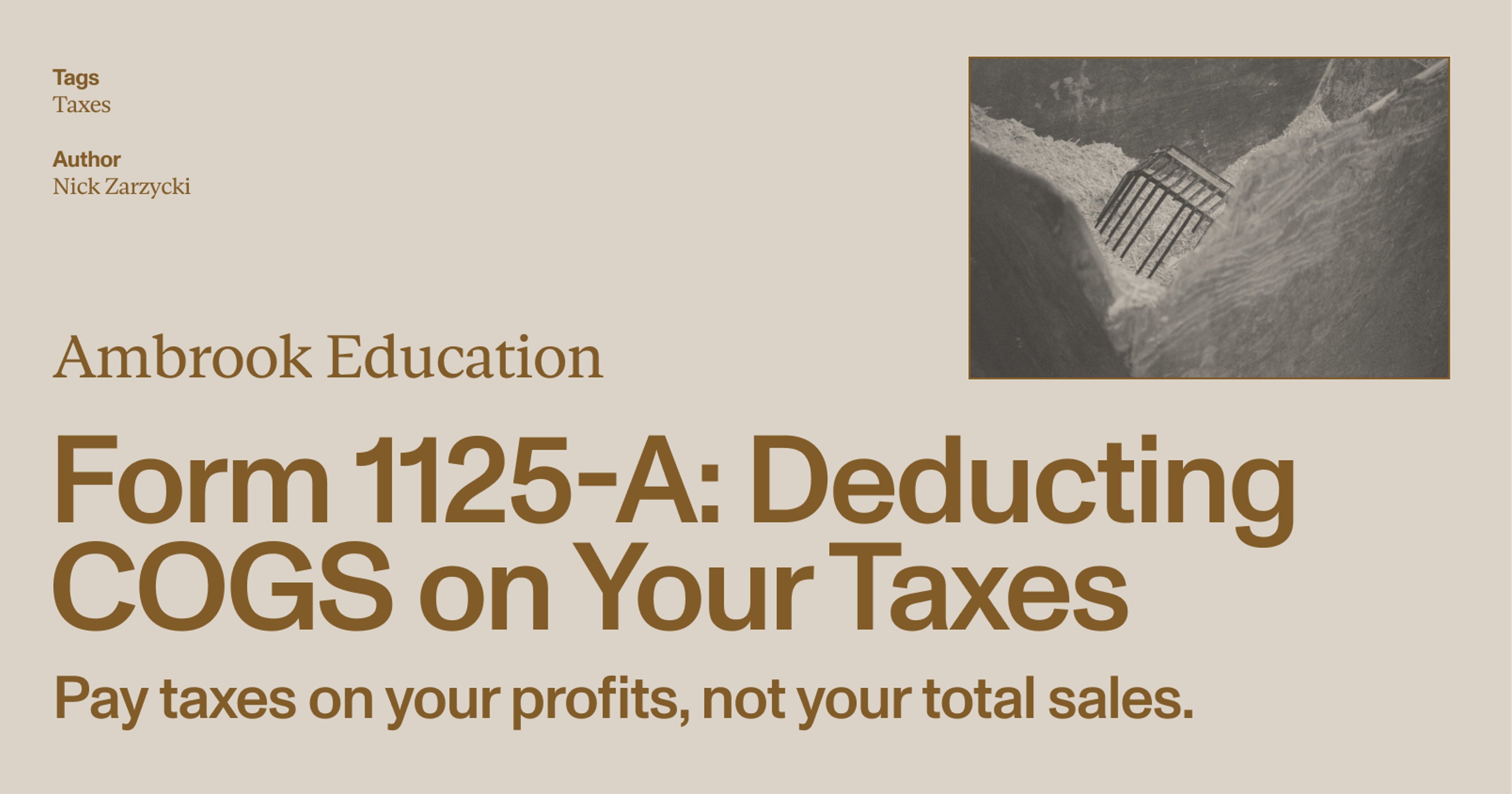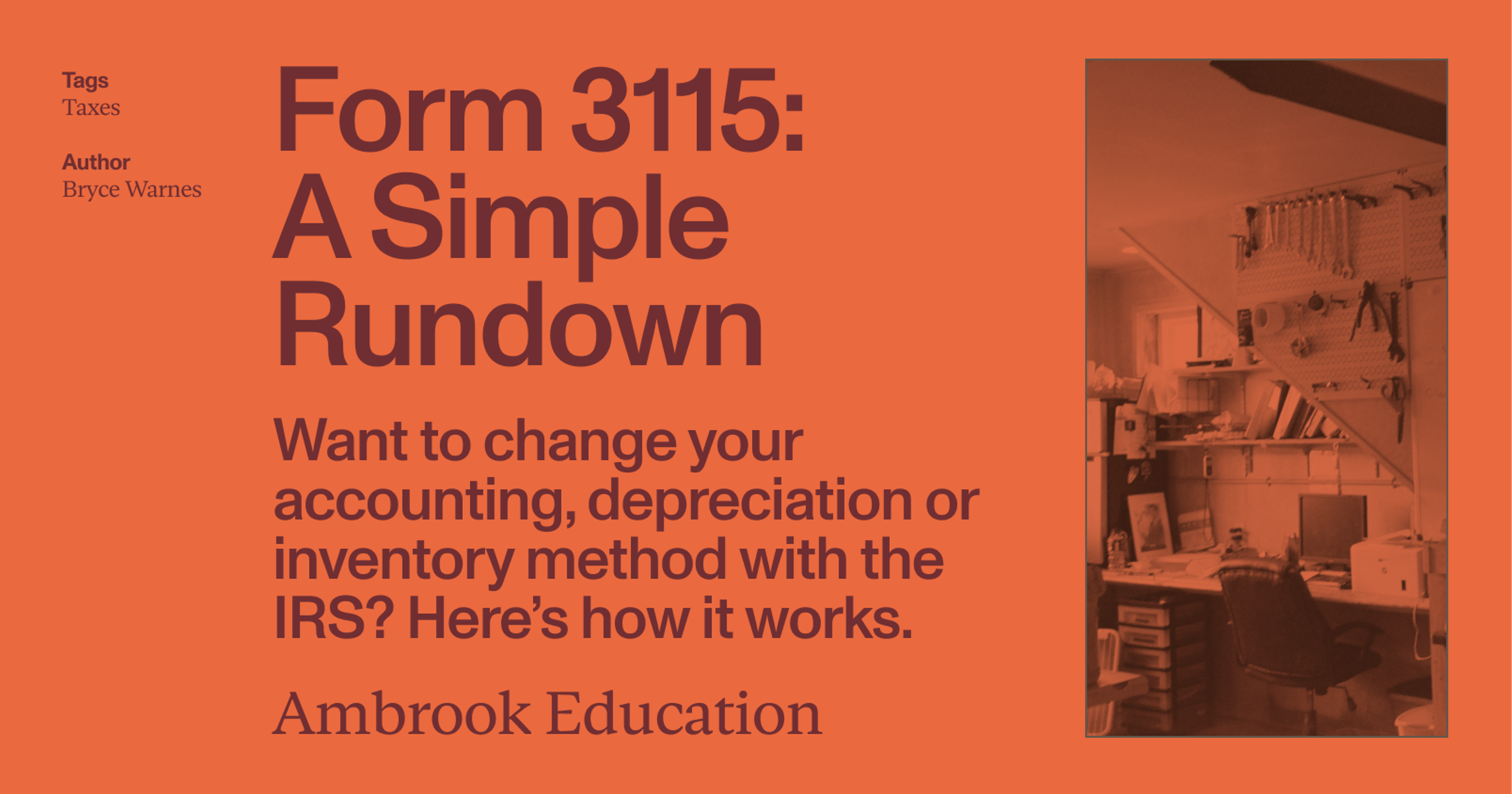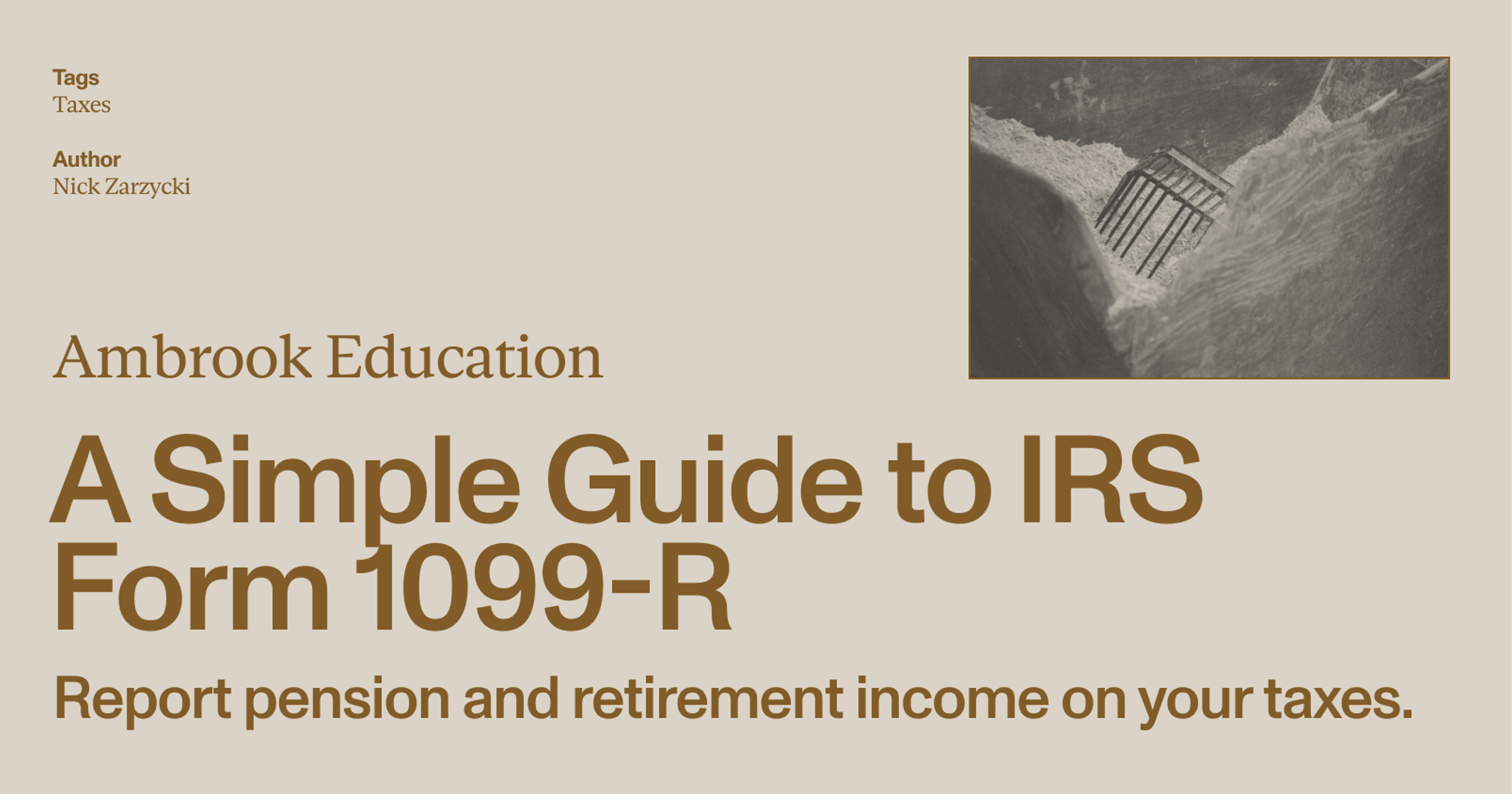S corporation status is popular among small businesses due to its tax benefits. Here’s how to file a tax return for one properly.
‘S Corporation’ is a special federal tax status that offers business owners the liability protection of a corporation while also allowing them to avoid double taxation and potentially lower their self-employment taxes.
In the same way that regular corporations file their taxes using Form 1120, S corporations file their tax return using Form 1120-S. Here’s what you need to know before you file.
What is an ‘S corporation?’
In short, it’s a special federal tax status that offers limited liability protection like a regular C corporation, while also letting you avoid double taxation like sole proprietorships, partnerships and LLC status do.
“S corporation” is a bit of a misnomer. Unlike a C corporation or an LLC, which are state-created entities, “S corporation” is a special tax status. You don’t “incorporate” an S corporation: rather, you “elect S corporation status” by submitting IRS Form 2553.
Why do businesses elect S corporation status?
Before ‘S corp’ status came along in the 1950s, small business owners had two options for structuring their business:
They could become C corporations to protect their personal assets from business liabilities, but then agree to be ‘double taxed’--i.e., pay corporate tax on business income, and then pay taxes again on any earnings or profits they receive from the business.
They could be sole proprietorships or partnerships to avoid double taxation, but then forego liability protection.
S corporations enjoy the same limited liability protections that C corporations do, but instead of getting double taxed, their income is “passed through” directly to the business owners, who report and pay taxes on that income on their personal tax returns.
The “S” in “S corporation” stands for “small business,” because it’s designed to make life easier for small businesses by giving them the best of both worlds.
How is S corporation status different from an LLC?
LLCs also offer both liability protection and pass-through income–so what makes S corporation status so special?
Basically, S corporation owners don’t have to pay self-employment taxes (i.e. Social Security and Medicare) on any profits they withdraw from the business above and beyond their reasonable salary.
They still pay income tax on their share of profits from the business at their ordinary income tax rate, but avoiding self-employment taxes on a portion of the profits can save them a lot in taxes if they expect the business to earn a lot more than their salary. Just remember: the IRS has strict rules around what constitutes a “reasonable salary,” and it will probably notice if you set your salary too low to take advantage of this rule.
| Business Liability Protection | Income Passed Through | Self-Employment Income Savings | |
|---|---|---|---|
| C Corporation | ✔ | ✔ | |
| Sole Proprietorship, Partnership | ✔ | ||
| LLC | ✔ | ✔ | |
| S Corporation | ✔ | ✔ | ✔ |
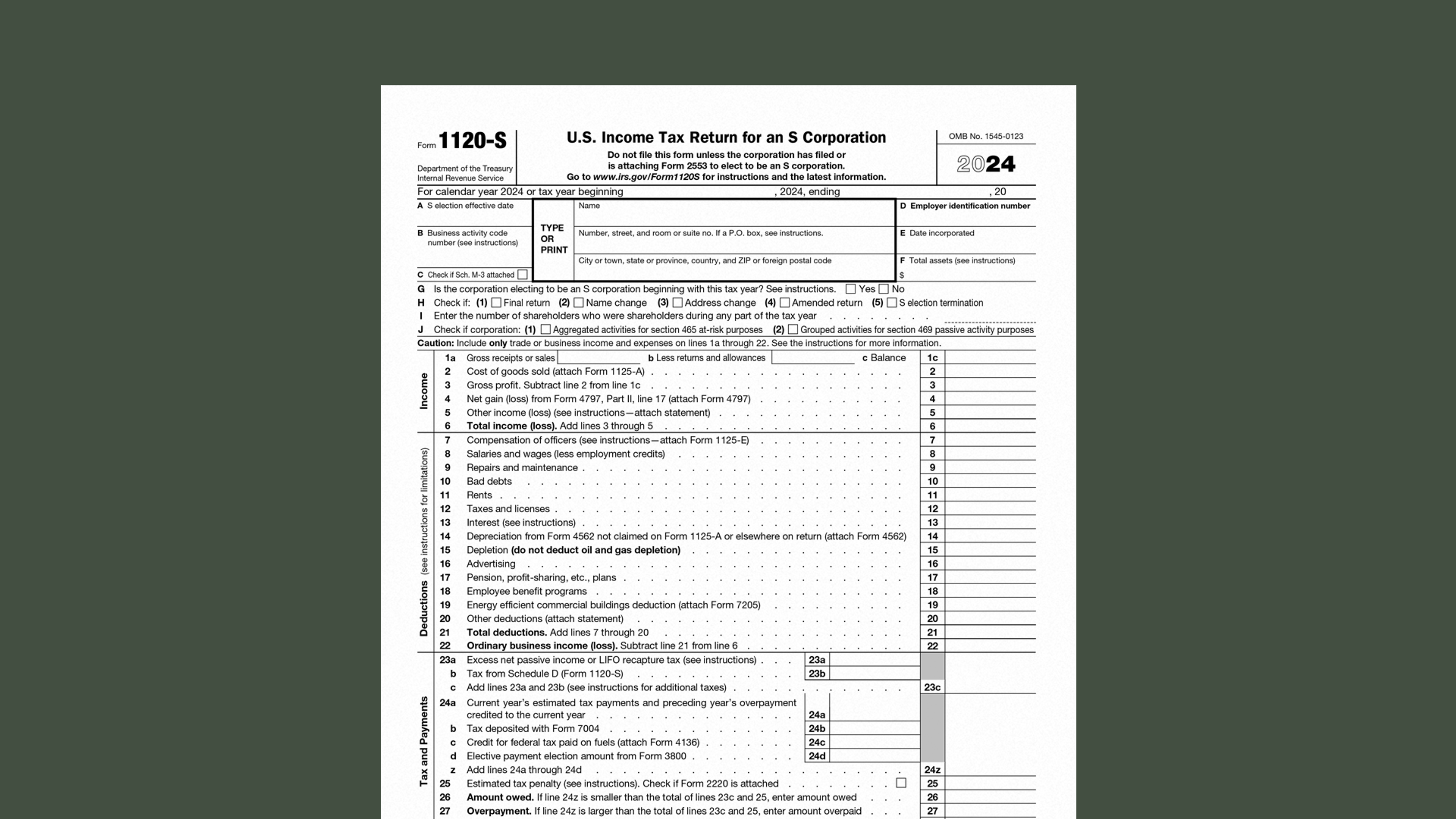
What is Form 1120-S?
Form 1120-S is the IRS tax form that S corporations use to file their annual tax return.
In addition to the main form, which is one page long, it comes with a series of schedules labelled B, K, L, M-1 and M-2, each used to provide the IRS with additional information about the business’ ownership, income, assets and liabilities.
Which tax forms do I need to complete an S corporation tax return?
Form 1120-S isn’t the only IRS form you’ll need to prepare to file your S-corp tax return properly.
If you sold any assets during the year you’re filing for, you might have to file Form 4797 or Form 8949. If your business has any income to report from an installment sale, you’ll also have to file Form 6252. If you have any capital gains or losses to report for any of those transactions, you’ll also need to file Schedule D of Form 1120-S.
Consult the “Assembling the Return” section of the instructions to Form 1120-S for a complete list of tax forms you’ll need to file an S corporation tax return properly.
When is Form 1120-S due?
In 2025, Form 1120-S and all of the other parts of your S corporation tax return are due on March 17th. You can file for an automatic 6-month extension by filing IRS Form 7004, however you must still pay your taxes on time.
What is the difference between IRS Form 1120 and 1120-S?
Form 1120 is a separate IRS tax form used by C corporations to file their annual tax return. Form 1120-S is the tax form S corporations that have filed Form 2553 use to file their annual tax returns.
How to file Form 1120-S
The main part of Form 112-S is divided into four sections: lines A-J which list out general information about the business, Lines 1-6 which list out income information, Lines 7-22 for deductions, and lines 23-28 for tax and payments information.
Lines A-J: S-Corporation Information
Here you’ll enter basic information about your business, including:
the date it elected S corporation status
its business activity code
name and address
employer identification number
incorporation date
total assets in $
number of shareholders
any changes to this information
Line 1-6: Business Income

In this section you’ll provide some basic information about your business’ income, including your gross profit (Line 3), which you’ll calculate by subtracting returns and allowances (Line 1b) and cost of goods sold (Line 2) from gross receipts and sales (Line 1a). To calculate your cost of goods sold, complete and attach Form 1125-A.
If you reported any net gain on Form 4797, Part II, line 17, enter that amount on Line 4 and attach Form 4797. Report any other income on Line 5, and record total income on Line 6.
Line 7-22: Business Deductions
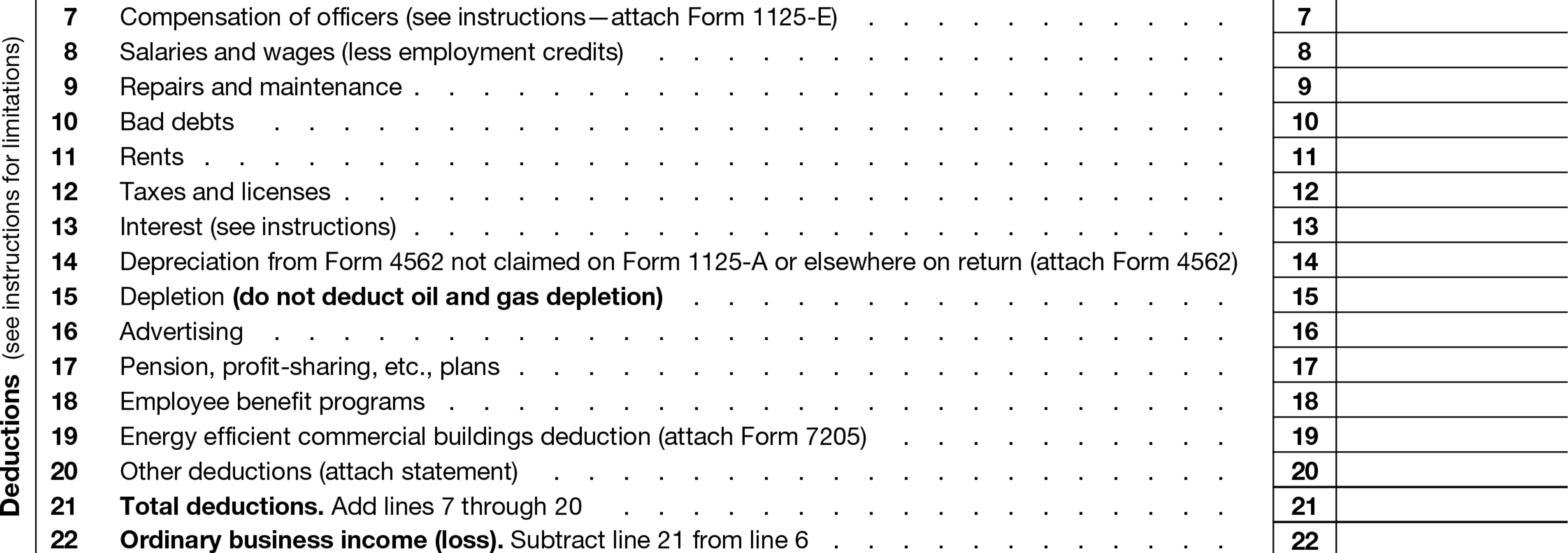
Here you’ll claim business deductions for your S corporation, including:
Line 7: If your business had total receipts of $500,000 or more, you’ll report compensation of officers here and attach Form 1125-E
Line 8: Total salaries and wages paid to the business’ employees (less employment credits)
Line 9: Repairs and maintenance expenses related to the business (remember that if an activity improves or increases the value of an asset, it must be capitalized and depreciated instead).
Line 10: Report any bad debts here. (Use Form 8949 to report nonbusiness bad debts.)
Line 11: Record any rents paid for the use of buildings, vehicles, equipment or any other property used by your business here.
Line 12: Use this line to record any taxes and licenses that aren’t reported elsewhere on your return.
Line 13: Record interest your business incurred that isn’t claimed elsewhere on the return here.
Line 14: Enter any depreciation you claimed on business assets by completing Form 4562 here, less any depreciation you claimed on Form 1125-A or elsewhere on the return. Attach Form 4562 to your return.
Line 15: Enter any depletion expenses, which is similar to depreciation, but applies to natural resources like timber or mineral deposits on your land.
Line 16: Use this line to record any advertising expenses you paid during the year.
Line 17: Record any deductible contributions made by the corporation to pension, profit-sharing, annuity, or any and other similar plans not claimed elsewhere on the return.
Line 18: Record any fringe benefits paid, including contributions to accident and health plans, group term life insurance and meals and lodging.
Line 19: Record the energy efficient commercial buildings deduction here if you’re claiming it, and attach Form 7205.
Line 20: Enter any deductions you didn’t claim elsewhere on the return here, including amortization, business start-up costs, and legal fees.
Lines 21-22: Add up lines 7 through 21 and enter your total deductions on line 21. Then subtract line 21 from line 6 to come up with your ordinary business income or loss, and enter the result on line 22.
Line 23-28: Tax and Payments

Line 23: If your corporation was previously a C corporation, it might be subject to the excess net passive income tax or the LIFO recapture tax, and will have to report them on Line 23a. (See the instructions to 1120-S for how to calculate.) Record any taxes figured on Schedule D (Form 1120-S) on Line 23b.
Line 24: Enter any estimated tax payments or previous year overpayment amounts on Line 24a, tax deposited with the Form 7004 extension on Line 24b, federal tax paid on fuels credit here (attach Form 4136), and the elective payment election amount from Form 3800 on Line 24d.
Line 25: Record any estimated tax penalties here and attach Form 2220 if you do.
Form 1120-S, Schedule B: Other Information
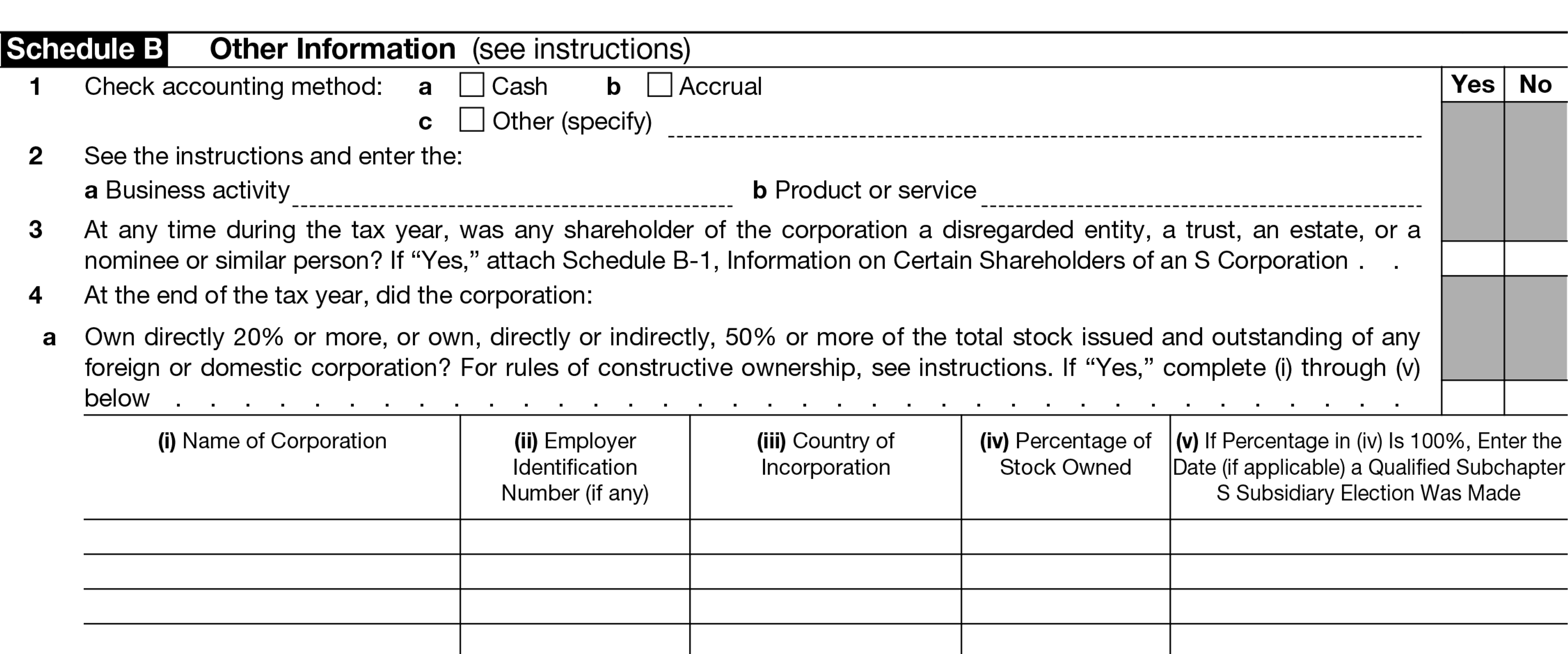
This schedule to Form 1120-S asks business owners some important questions about their accounting methods, business type, and shareholders.
Many of these are “Yes” or “No” questions about the business’ ownership structure and stock, including whether the corporation owned or owns stock in any foreign or domestic corporations, whether the corporation has any outstanding shares of restricted stock, or any outstanding stock options.
If the corporation filed or is required to file Form 8918 or Form 8281, you’ll report that on Line 6 and Line 7 respectively.
If you aren’t a small business taxpayer (i.e., $30 million in annual receipts or more) and have excess business interest expense from a partnership, you’ll have to file and attach Form 8990 and report on Line 10.
If you answer “No” to either question 11a or 11b, you’ll have to complete and attach Schedules L and M-1.
Pay special attention to lines 14a and 14b on Page 3. You’ll need to answer yes or no to tell the IRS whether you made any payments that would require you to file 1099 forms and, if so, whether you have or will file those forms. If you answer “yes” to question 14a, the IRS will expect to receive 1099s from you.
Schedule K: Shareholders’ Pro Rata Share Items
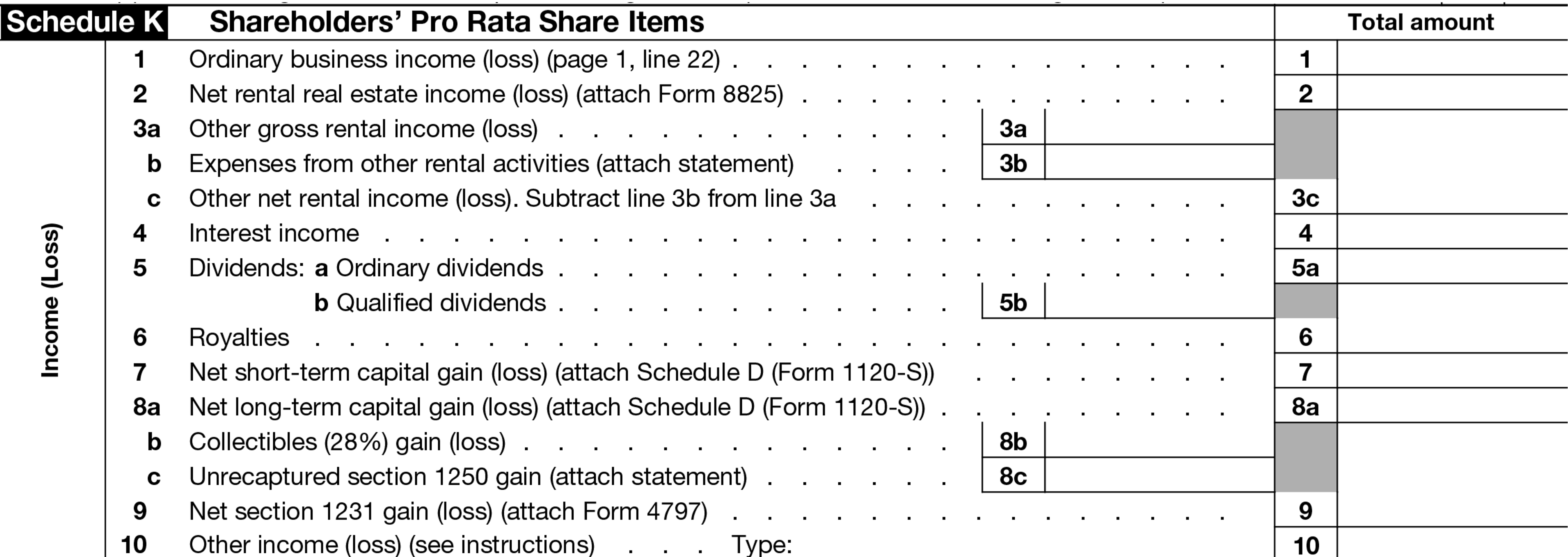
Use Schedule K to summarize all shareholders’ shares of the corporation’s income, deductions, credits, and so on.
You’ll need to complete and attach Form 8825, Schedule D (Form 1120-S) and Form 4797 to complete the income section of Schedule K.
You’ll also need to complete and attach Form 4562 if you’re taking the Section 179 deduction, Form 3468 if you’re claiming the qualified rehabilitation expenditures credit, and Form 6478 if you’re claiming the biofuel producer credit.
Form 1120-S, Schedule K-1 Instructions
In addition to Schedule K, make sure to also include a copy of every Schedule K-1 your shareholders file, which is a separate form that provides the same information you provided on Schedule K, except broken down for each separate shareholder.
Schedule L and M-1
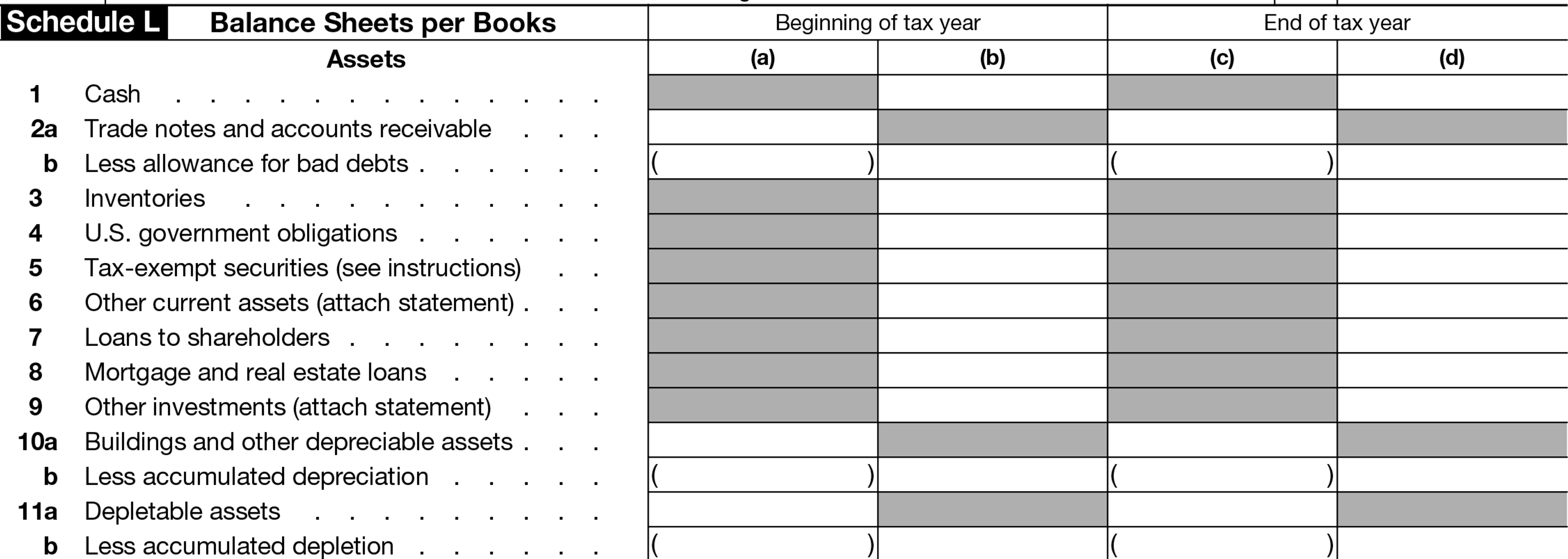
If you answer “No” to either question 11a or 11b (i.e., your total annual receipts and/or total assets were above $250,000) you’ll have to file Schedule L, which is just your business’ balance sheet. Accounting software like Ambrook can help you generate a balance sheet for your business automatically.
You’ll also have to complete Schedule M-1, which is a short form used to reconcile your corporation’s book income with the income it’s reporting on its tax return. (You’ll need to complete Form 1120-S, Schedule K before completing this schedule.)
Form 1120-S, Schedule M-2

Schedule M-2 is a short form that summarizes certain important adjustments relating to S corporations. (See the instructions to 1120-S for a full breakdown.)
Kickstart Your Tax Season with Ambrook
Ambrook’s category tags correspond directly to each line on Schedule F, making it easy to compare your tax return to your records and saving you hours of work during tax season.
With time-saving bookkeeping automation features, automatically-generated financial reports, streamlined bill pay and invoicing, and other powerful accounting and financial management tools, Ambrook doesn’t just make filing your taxes easy: it takes the guesswork out of running your business. Want to learn more? Schedule a demo today.
This resource is provided for general informational purposes only. It does not constitute professional tax, legal, or accounting advice. The information may not apply to your specific situation. Please consult with a qualified tax professional regarding your individual circumstances before making any tax-related decisions.

